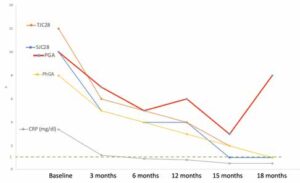This condition, PGA near remission, was over 50% more common than 4V remission in a meta-analysis of 12 clinical cohorts, with more than 23,000 patients: 19% vs. 12%.17 Overall, 61% of patients with RA otherwise in remission miss the established target solely due to a PGA score greater than 1.
These patients are highly unlikely to be improved by additional immunosuppressive therapy because the disease process is already under (nearly) full control. They are, therefore, exposed to the risk of overtreatment if the treat-to-target strategy and EULAR recommendations are followed strictly.
It has been argued that wise clinicians will not increase immunosuppression in patients whose only obstacle to remission is the PGA, such as Linda in our scenario (see Figure 2). Shouldn’t clinical wisdom also be incorporated in recommendations, especially when computer-based treatment decisions are being considered?18
Poor Representation of Patient Needs
The PGA provides no information whatsoever on the underlying causes of persistent disease impact on a patient’s quality of life. This makes it useless to help the caring physician decide what sort of adjunctive measures, if any, may be appropriate to improve the patient’s condition, especially after remission of the biologic process has been achieved. In fact, a high PGA can be caused by a variety of different domains, including pain, function and depression, requiring different interventions.13

Figure 2: Linda’s Individual Components of Disease Activity
(Legend: CRP, C-reactive protein; TJC28, Tender Joint Counts in 28 joints; SJC28,
Swollen Joint Counts in 28 joints; PGA, patient’s global assessment of disease activity; PhGA, physician’s global assessment of disease activity)
CLICK TO ENLARGE
Moreover, it is reasonable to believe that incorporating this single patient-reported outcome in the definition of treatment target feeds the illusion that disease impact is accounted for and, in our opinion, wrongly relieves the clinician of the obligation to pay additional attention to the patient’s perspective.
Back to the Scenario
Having these considerations in mind, Dr. Snow decides to take a look at the individual domains of disease activity (see Figure 2).
The PGA is the only criterion that worsened from the previous visit. In fact, it is the only criterion above 1—the sole factor keeping Linda from reaching Boolean remission criteria.
Dr. Snow decides not to adjust Linda’s current therapy and sets out to understand the reasons underlying the persistent impact of the disease, despite biologic remission. He finally decides to treat her depression.
The Dual-Target Strategy
The dual-target strategy involves two main changes to the current standards:
- Sharpening the current definitions of remission, the biologic target, by removing PGA and using these definitions to guide immunosuppressive therapy, and
- Adding a novel target focused on the impact of disease upon the life of the patient (symptom remission).12,19,20
The operational definition of the second target is still to be defined, but it would be best served by instruments that reflect the multidimensional nature of disease impact, as perceived by patients. We believe the RA Impact of Disease (RAID) score is especially suited for this purpose.21 RAID addresses seven domains of disease impact selected by patients with RA: pain, functional capacity, fatigue, physical and emotional wellbeing, sleep, and coping.
